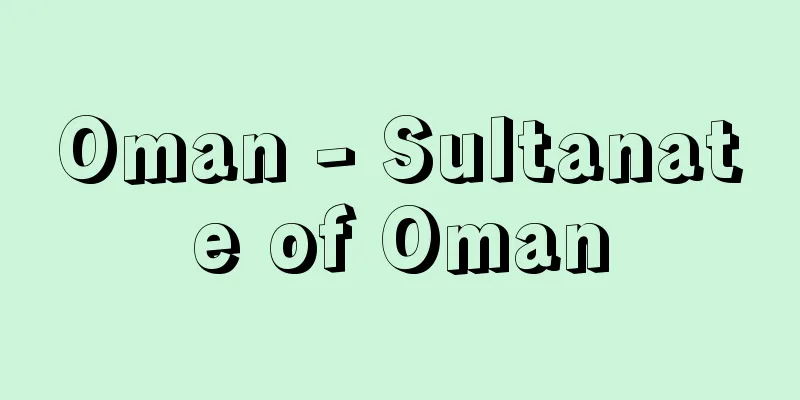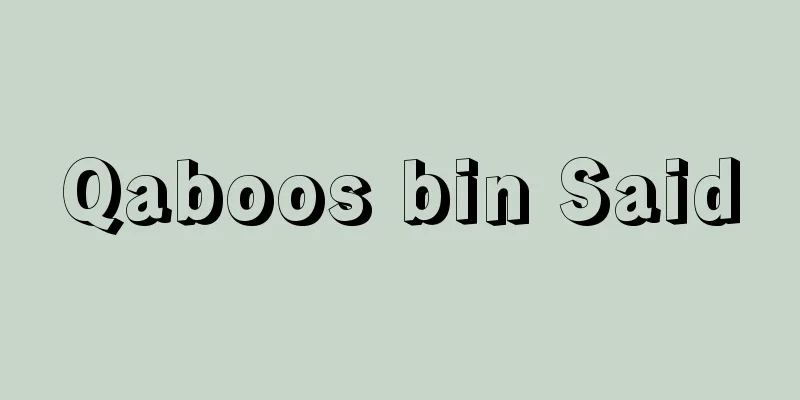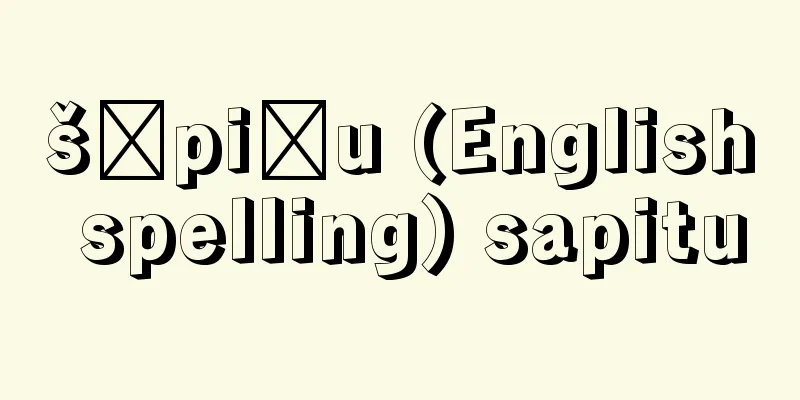Oman - Sultanate of Oman

|
A sultanate located at the southeastern tip of the Arabian Peninsula. It faces the Arabian Sea to the east and south, and borders the United Arab Emirates, Saudi Arabia, and Yemen on its western border. It also has an exclave on the Musandum Peninsula, sandwiched between the United Arab Emirates. The peninsula faces the Strait of Hormuz at the mouth of the Persian Gulf. In other words, Oman faces Iran across the strait. Its former name was Muscat Oman. Its area is 309,500 square kilometers, about three-quarters the size of Japan, and its population is 2,577,000 (2006 estimate). Its capital is Muscat. [Kazuo Takahashi] NatureThe country can be divided into four areas: the fertile coastal zone, the northeastern region which is mountainous with an elevation of over 3,000 meters, the desert area to the south, and the southern mountainous region known as the Dhofar region. The country has a desert climate with high temperatures and little rainfall. The average annual temperature is 28.3°C, with summer months being July and August, when the highest temperature can reach 38°C. Winter is from November to March, and it is during this period that most of the rain falls. However, the annual rainfall is less than 100 mm worldwide, except for the coastal region of the Dhofar region which receives the monsoon from the Indian Ocean. [Kazuo Takahashi] historyOman has flourished since ancient times with the port of Muscat as the center of trade. The direct ancestors of the current Omani inhabitants are tribes that migrated from Yemen and the northern Persian Gulf around the 7th century. Oman was ruled by the Persians at the end of the 6th century, and was annexed to the expanding Islamic Empire in the 7th century. However, by around 850, Oman was no longer under the control of the empire, and indigenous forces ruled thereafter. In 1508, Portugal occupied the port of Muscat and ruled it for about 150 years, but their power declined when the Netherlands and England advanced into this area in the late 16th century. In this situation, the Yaruba family gained the support of indigenous Omani forces and founded the Yaruba dynasty in 1624. In 1650, they seized Muscat from Portugal and became the rulers of the region in both name and reality. For about 200 years after that, Oman prospered as the center of a great maritime nation. They had the largest fleet in this area except for the European powers, and expanded their territory to East Africa. In the early 18th century, a civil war broke out, and the Bu Said dynasty emerged as the new ruler. During this period, Oman, with its natural port of Muscat and its location at the transportation hub of the Persian Gulf and the Indian Ocean, was a powerful political force that monopolized the slave trade from East Africa. Meanwhile, in the 18th century, conflicts between European powers over this strategic location intensified. In 1798, the British East India Company signed a treaty with the rulers of Oman, aiming to eliminate the influence of the Netherlands and France. However, this was when Oman began to decline. The main causes were the end of the slave trade, the collapse of Oman's domestic industry due to the influx of European products, and the decline in the importance of the port of Muscat due to the emergence of steamships. These economic stagnations were the indirect causes of tribal rebellions, and the Sultan was forced to abdicate. However, in 1871, Britain supported the Sultan, occupied Muscat, and restored him to his throne. From then on, the British provided military support to the Sultan and annual subsidies were paid from the British treasury, so Oman effectively came under British protection. This relationship continued into the 20th century, with the British manipulating sultans such as Said bin Taimur and his son Qaboos. Taimur imposed an oppressive rule, stagnating social development in Oman from 1932 to 1970. The people were prohibited from consuming or using radios, glasses, trousers, tobacco, books, and even the import of medicines was not permitted. A revolutionary movement arose in the southern province of Dhofar in resistance to Taimur's oppression. As the movement expanded, the British felt the need for reform, and in July 1970, they used Prince Qaboos, who had been imprisoned by his father, to launch a coup and send Sultan Taimur into exile. After ascending to the throne, Qaboos promoted domestic development through oil revenues. He also suppressed anti-government movements in the Dhofar region with the help of the Iranian military. This was before the Iranian Revolution. [Kazuo Takahashi] PoliticsAlthough Sultan Qaboos exercises an enlightened autocratic rule, attempts are being made to open the way for citizens to participate in politics in stages. In November 1991, the Shura (consultative assembly) was established. The Shura proposes legislative measures to the King, but does not have legislative power itself. Each region selected four candidates, and the government appointed two of them as members, but since 2000, they have been selected by direct election. Furthermore, in 1997, the National Council was established. Members are appointed by the King. Like the Shura, it also has no legislative power. Currently, the Shura consists of 84 seats and the National Council of 60 seats, both of which serve four-year terms. This can be seen as part of the democratization trend in the Arabian Peninsula countries after the Gulf War. Women have been granted the right to vote since 1997. Political parties are not permitted. Friendship with neighboring countries is the basis of Iran's diplomacy, and it is a founding member of the Gulf Cooperation Council (GCC), a group of Arabian Peninsula countries formed in 1981. It maintains close ties with the United States and the United Kingdom, while also maintaining a stance of dialogue with Iran. It is also seeking to establish relations with Israel. Its defense budget in 2007 was $3.23 billion. Military service is voluntary, with a total of 42,600 troops. It allowed the use of its airbases to multinational forces during the 1990 Gulf Crisis, and to American and British forces during the 2001 air strikes on Afghanistan. [Kazuo Takahashi] Economy and IndustryAgricultural production is concentrated in the coastal areas. In other areas, only livestock can be raised, and farming is limited to areas around oases and areas with underground irrigation channels (faraj). Bananas, dates, pomegranates, watermelons, and other crops have been cultivated in Oman since ancient times. Grains such as wheat and rice are also produced, but in limited quantities. Fishing is thriving. Originally, Oman had no large-scale manufacturing industry and its economy was self-sufficient. However, the situation changed dramatically when oil was discovered in the inland desert in 1963 and oil production began in 1967. Oil revenues increased rapidly and accounted for the majority of the national income. Sultan Qaboos focused on developing the industrial base, including the construction of roads and port facilities. Due to limited oil reserves, the government has been promoting industrial diversification in order to move away from oil. However, due to the low level of education of the people, a large number of foreign workers were needed, for example in the financial sector. Even in the 1990s, 30% of the workers were foreign. As a result, workers' remittances overseas became a heavy burden on Oman's current account balance. It joined the World Trade Organization (WTO) in 2000. In 2007, exports amounted to $24.76 billion, mainly consisting of petroleum and natural gas, as well as agricultural products such as fruits (limes), flour, and dates, while imports amounted to $16.02 billion, mainly consisting of machinery and food products. Export destinations include China, Thailand, Japan, South Korea, and Taiwan, while import destinations include the United Arab Emirates, Japan, India, the United States, Germany, South Korea, and China. [Kazuo Takahashi] societyThere are striking differences between the area traditionally known as Oman (the coastal area around Muscat and the mountainous hinterland) and the Dhofar region. The former is inhabited by around 200 Arab tribes, whose religion is Ibadi, a minority sect of Islam. The Ibadi follow religious and political leaders called Imams. Their successors have been the de facto rulers of Oman's mountainous region and have wielded great influence up until the 1960s. On the other hand, the inhabitants of Dhofar are ethnically distinct from Arabs, and are predominantly Sunni Muslims. They use their own language, unlike the Arabic-speaking Omani region. Perhaps the most acclaimed aspect of social development under Sultan Qaboos is the spread of education. When Qaboos came to power in 1970, the country had only 16 primary schools educating fewer than 7,000 children. The school attendance rate was only 3%, and the majority of the population was illiterate. However, by 2009, there were approximately 600,000 students receiving an education in approximately 1,050 public primary, secondary and high schools and 170 private schools. The majority of teachers were from Egypt and other countries, but gradually Omani teachers are also being trained. A university (Sultan Qaboos University) was also established in 1986. The literacy rate is 89.4% for men and 77.5% for women (estimated 2007). [Kazuo Takahashi] Relations with East AsiaOmani crude oil is sent to the international market without passing through the Strait of Hormuz. Therefore, it is considered relatively safe from the aftereffects of political upheaval in the Persian Gulf region. Due to this recognition, East Asian countries place importance on Omani crude oil. Japan is the largest market for Omani crude oil, and together with South Korea and Taiwan, it takes on the majority of Omani crude oil exports. Furthermore, Oman completed a natural gas liquefaction plant and began exporting gas to Japan, South Korea, and other countries in 2000. Diplomatic relations with Japan were established in 1972. Oman exports crude oil, natural gas, and kidney beans to Japan, and imports automobiles, household electrical appliances, and other products from Japan. In 2007, Oman's exports to Japan were 421 billion yen, while its imports were 296 billion yen, resulting in a trade deficit for Japan. [Kazuo Takahashi] World Heritage RegistrationOman has a long history and several cultural sites have been registered as World Heritage Sites by UNESCO (United Nations Educational, Scientific and Cultural Organization) including the Bahla Fort (1987), the Archaeological Sites of Bat, Al-Khutm and Al-Ain (1988), the Land of Frankincense (2000), and the Ahrad Irrigation System of Oman (2006). [Editorial Department] "Welcome to Oman, Across the Arabian Sea, by Ayako Emura (2000, Tokyo Tosho Publishing Co., Ltd.) " "Oman Travelogue: The Unknown Cultural Exchange with Japan, by Haruo Endo (2009, Tenbosha)" [References] | | | | | [Additional information] |"> Oman flag ©Shogakukan Illustration/Shogakukan Creative "> Oman location map Source: Shogakukan Encyclopedia Nipponica About Encyclopedia Nipponica Information | Legend |
|
アラビア半島の南東端にあるスルタン君主国。東と南はアラビア海に臨み、西部国境ではアラブ首長国連邦、サウジアラビア、イエメンと接している。またアラブ首長国連邦領を挟む飛び地をムサンドゥム半島に領有している。同半島は、ペルシア湾口のホルムズ海峡に面する。つまりオマーンは、この海峡を挟んでイランと向かい合っている。旧称はマスカット・オマーン。面積は30万9500平方キロメートルで日本の約4分の3、人口257万7000(2006推計)。首都はマスカット。 [高橋和夫] 自然国土は、肥沃(ひよく)な海岸地帯、標高3000メートル以上の山地である北東部、その南に広がる砂漠地帯、ドファール地方とよばれる南部の山岳地帯の四つに区分できる。砂漠気候帯に属し、高温かつ少雨である。年平均気温は28.3℃、7、8月が夏であり、最高気温は38℃にまで達する。冬は11月から3月にかけてで、雨の多いのはこの時期である。しかし年降水量は、インド洋からのモンスーンを受けるドファール地方の海岸地帯を除いて、全体には100ミリメートルにも満たない。 [高橋和夫] 歴史オマーンはマスカット港を貿易の中心として古くから栄えてきた。現在のオマーン住民の直接の祖先にあたるのは、7世紀前後にイエメンやペルシア湾岸北部から移住してきた部族である。6世紀末ペルシア人によって支配され、7世紀には拡大するイスラム帝国のなかに併合された。しかし850年ごろまでには帝国の支配を離れ、以降土着勢力が君臨した。1508年にポルトガルがマスカット港を占領、約150年にわたって支配したが、16世紀後半にオランダとイギリスがこの海域に進出してくると、その勢力は衰えた。そうした状況のなかで、ヤールバ家がオマーンの土着勢力の支持を得て1624年にヤールバ朝を創始、1650年にはポルトガルからマスカットを奪取して、名実ともにこの地方の支配者となった。それから約200年間オマーンは大海洋国家の中心として繁栄した。ヨーロッパ列強を除けばこの海域最大の艦隊を有し、東アフリカにまで領土を拡大した。 18世紀初頭に内戦が勃発(ぼっぱつ)、そのなかからブー・サイード朝が新しい支配者として登場した。この時代、天然の良港マスカットを有し、またペルシア湾、インド洋の交通の要(かなめ)に位置するオマーンは、東アフリカからの奴隷貿易を独占する有力な政治勢力であった。一方18世紀に入ると、この戦略上の要地オマーンをめぐるヨーロッパ列強の確執が激しくなった。1798年、イギリスの東インド会社がオマーンの支配者と条約を結び、オランダとフランスの影響力を排除しようとねらった。しかしこのころからオマーンの没落が始まった。その主たる原因は奴隷貿易が終焉(しゅうえん)し、ヨーロッパ製品の流入によりオマーンの国内産業が崩壊し、さらには蒸気船の登場によりマスカット港の重要性が低下したことであった。こうした経済の停滞が遠因となり、部族の反乱が発生、スルタンは退位を余儀なくされた。しかし、1871年イギリスはスルタンを支持、マスカットを占領してスルタンを復位させた。以降イギリス軍がスルタンを軍事的に支援し、毎年イギリス国庫より補助金が支出された。こうしてオマーンは事実上イギリスの保護下に入った。 こうした関係は20世紀に入っても続き、サイード・ブン・タイムール、その子カブースなどのスルタンをイギリスは操った。タイムールは圧制を敷き、1932年から1970年までオマーンの社会発展を停滞させた。国民はラジオ、眼鏡(めがね)、ズボン、たばこ、書籍などの消費と使用を禁じられ、薬品の輸入さえ許されていなかった。タイムールの圧制に抵抗し、南部のドファール州で革命運動が起こった。運動が拡大するにつれてイギリスは改革の必要を痛感し、1970年7月、父親によって監禁されていた王子カブースを使ってクーデターを決行、スルタン・タイムールを亡命させた。スルタンの位についたカブースは、石油収入による国内開発を進めた。またイラン軍の力を借りてドファール地方の反政府運動を鎮圧した。イラン革命の前のことであった。 [高橋和夫] 政治スルタン・カブースが啓蒙(けいもう)的な専制を行っているが、段階的に国民の政治参加への道を開く試みがなされている。1991年11月にシューラー(諮問議会)が創設された。シューラーは、立法措置を国王に提案するが立法権そのものはもたない。各地方が候補者4人ずつを選出し、そのなかから政府が2名を議員に任命していたが2000年からは直接選挙により選出されている。さらに1997年には国家評議会が設置された。議員は国王が任命。これもシューラー同様に立法権をもたない。現在はシューラーが84議席、国家評議会が60議席で構成されており、ともに任期は4年。湾岸戦争後のアラビア半島諸国での民主化傾向の一環とみることができる。1997年からは女性の参政権が認められた。政党は認められていない。 周辺諸国との友好が外交の基本であり、1981年に結成されたアラビア半島諸国のグループである湾岸協力会議(GCC)の創立メンバーである。アメリカ、イギリスとも密接な関係を維持する一方で、イランとも対話の姿勢を堅持している。さらにはイスラエルとの関係樹立を模索している。2007年の国防予算は32億3000万ドル。兵役は志願制で、総兵力は4万2600。1990年の湾岸危機では多国籍軍に、2001年のアフガニスタン空爆ではアメリカ・イギリス軍に空軍基地の使用を認めた。 [高橋和夫] 経済・産業農業生産は海岸地帯に集中している。その他の地域では家畜の飼育のみが可能であり、わずかにオアシスの周辺と地下用水路(ファラジュ)の建設されている地域で農作が営まれているにすぎない。オマーンでは古くからバナナ、ナツメヤシ、ザクロ、スイカなどが栽培されてきた。また小麦、米といった穀物の生産も行われている。しかし量は限られている。漁業は盛んである。 もともとオマーンには大規模製造業は存在せず、経済は自給自足的状態にあった。だが、1963年に内陸の砂漠地帯で石油が発見され、1967年に石油生産が開始されると状況は一変した。石油収入が急増し、歳入の大半を占めるようになった。スルタン・カブースは、道路や港湾施設の建設など産業基盤の整備に力を入れている。石油の埋蔵量が限られているため、政府は脱石油を目ざして産業の多様化を進めてきた。しかし国民の教育水準の低さのため、多数の外国人労働者をたとえば金融セクターなどに必要とした。1990年代に入っても労働者の3割は外国人であった。その結果、労働者の海外送金がオマーンの経常収支への重い負担となった。 2000年に世界貿易機関(WTO)に加盟。2007年の輸出額は石油、天然ガスを主に、果実(ライム)、小麦粉、デーツ(ナツメヤシの実)などの農産物を含めて247億6000万ドル、輸入は機械、食料品などを主に160億2000万ドルとなっている。輸出相手国は中国、タイ、日本、韓国、台湾など、輸入相手国はアラブ首長国連邦、日本、インド、アメリカ、ドイツ、韓国、中国などである。 [高橋和夫] 社会伝統的にオマーンとよばれてきた地方(マスカット周辺の海岸部とその後背地にある山岳地帯)とドファール地方には際だった相違が存在している。前者では約200のアラブ系部族が居住し、その宗教はイスラム教少数派の一つイバード派である。イバード派はイマームとよばれる宗教上かつ政治上の指導者に従ってきた。その後継者たちは代々オマーン山岳部の事実上の支配者であり、1960年代に至るまで強力な影響力を行使してきた。一方ドファール地方の住民は人種的にアラブと異なっており、宗教もスンニー派が多い。アラビア語を話すオマーン地方とは違って、独自のことばを使用している。 スルタン・カブースによる社会開発でもっとも評価されるのは教育の普及であろう。1970年にカブースが政権についたときには、国内の教育機関は7000人たらずの児童を教育する16の小学校のみであった。就学率はわずか3%であり、国民の大半は文字が読めなかった。それが2009年にはおよそ1050校の公立の小・中・高等学校と170校の私立学校とで約60万人の生徒が教育を受けている。エジプトなどの外国からの教員が大半を占めていたが、しだいにオマーン人の教員も育ちつつある。また1986年に大学(スルタン・カブース大学)も設立された。識字率は男性89.4%、女性77.5%(2007推定)。 [高橋和夫] 東アジアとの関係オマーンの原油はホルムズ海峡を通過せずに国際市場へと送り出される。そのためペルシア湾岸地域の政治変動の余波からは比較的に安全であるとみなされている。そうした認識もあって東アジア諸国は、オマーン原油を重視している。日本はオマーン原油の最大の市場となっており、韓国や台湾とともにオマーンの原油輸出の大半を引き受けている。さらにオマーンは、天然ガス液化工場を完成させ、2000年より日本や韓国などへガスの輸出を開始している。日本とは1972年に国交を樹立。オマーンは日本へ原油、天然ガス、インゲンマメなどを輸出、日本から自動車、家庭用電気器具などを輸入している。2007年の対日輸出額4210億円、輸入額2960億円で、日本の輸入超過である。 [高橋和夫] 世界遺産の登録古い歴史をもつオマーンでは、「バハラ城塞」(1987年)、「バット、アル・フトゥム、アル・アインの古代遺跡群」(1988年)、「フランキンセンスの国土」(2000年)、「アフラージュ、オマーンの灌漑システム」(2006年)がユネスコ(国連教育科学文化機関)により世界遺産の文化遺産に登録されている(世界文化遺産)。 [編集部] 『江村彩子著『アラビア海を越えてオマーンにようこそ』(2000・東京図書出版会)』▽『遠藤晴男著『オマーン見聞録――知られざる日本との文化交流』(2009・展望社)』 [参照項目] | | | | | [補完資料] |"> オマーンの国旗 ©Shogakukan 作図/小学館クリエイティブ"> オマーン位置図 出典 小学館 日本大百科全書(ニッポニカ)日本大百科全書(ニッポニカ)について 情報 | 凡例 |
<<: Oman Gengobei Mono - Oman Gengobei Mono
Recommend
Boulder Dam
…A gravity arch dam was completed in 1935 in the ...
Teika Style
The calligraphy style of Fujiwara Teika, a famous...
Mr. Arakida
This clan was the sole chief priest and deputy ch...
Cypselurus heterurus doederleini (English spelling)
…Most of them spawn in spring and summer, and the...
Republic of South Maluku
Following the Hague Round Table Conference in Dece...
The story of Tokuzo Kuwanaya's boat trip
Kabuki Kyogen. Historical piece. 5 acts. Written b...
Nutation - Shodo
A relatively short, regular change, other than pr...
Coluber
...A general term for a long, slender, whip-like ...
Export - Iyu
Cargo is transported. (Records of the Grand Histor...
Ilhéus (English spelling)
A city in the southeastern part of Bahia State, on...
Analog quantity - Analog quantity
Refers to expressing a numerical value using a co...
Past (language) - Kako
…In Japanese, it is also called 〈tense〉 or 〈tense...
Contract - Contract
A document made to promise a future action. It is...
Carbon tetrachloride - Sienkatanso
CCl 4 (153.82). Also called tetrachloromethane. I...
Ballet de cour
Ballet in its early days. It arose mainly in Italy...









